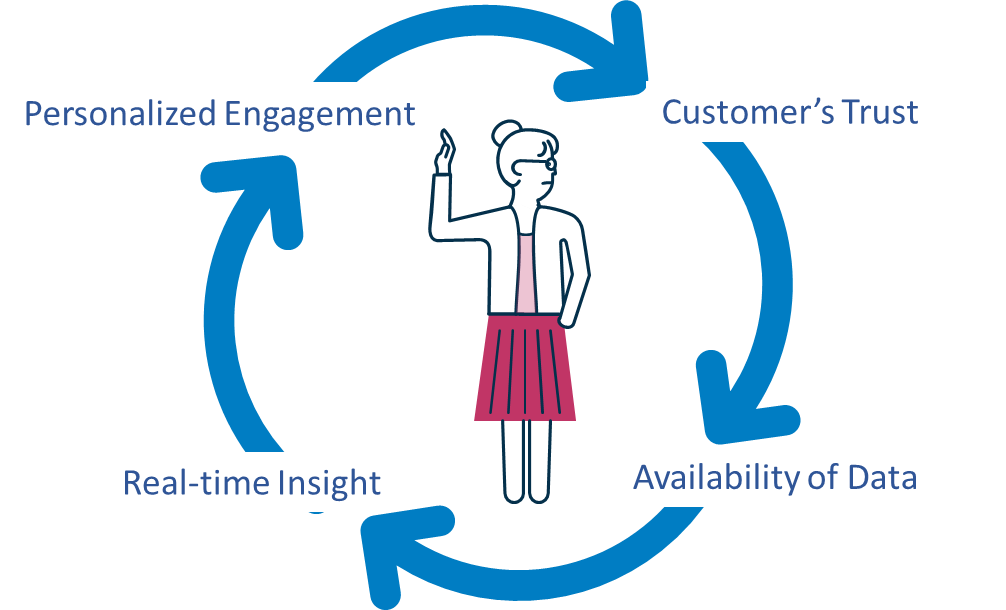Much has been said about the benefits of personalized customer engagements and the importance of customer-centricity. However, customer experience surveys show that most customers are still not happy and many brands still do not provide relevant and personalized communications to their customers.
A recent Gartner report suggested that 80% of personalization initiatives will not achieve the desired results or ROI, and will be abandoned by 2025. Gartner identified three barriers to successful personalization: declining customer trust, regulatory barriers and technology. Other surveys also show similar results, including:
- Customers now trust brands less and are often sceptical about how brands use data.
- Customers want to share their data with brands when they believe that brands would use this information to provide more personalized and less intrusive communications.
- Brands want to personalize communicate with their customers to gain trust.
- Problems with personalization include lack of availability of data and not having the required technology.
- A recent study by SAS and Futurum (CX2030) also highlights the gap between customers’ and brands’ views of what customers want.
Surprisingly, though, the CX2030 study showed that customers are willing to provide data to support more personalized recommendations and communications. In other words, brands want to provide personalize communication and need more data to do so. Customers want more personalized communication and will share data to achieve this. So why is personalization not happening? I have developed a construct to explain this, which I call the "trust cycle."
The trust cycle
The trust cycle is a circular construct, connecting customer trust, availability of data, real-time insight and personalized engagement (similar to the income-consumption model from macroeconomics). You can move around the circle in both directions. Once in motion in any direction, the movement is self-propelled. It usually moves faster going down, and slower going up, a bit like the impact of gravity. In simple marketing terms, this means that once you have lost customer trust, you will continue to do so – unless you make some serious changes in what you are doing.
I said that you could move in both directions – and also that movement was self-propelling. This means that to reverse the direction of travel, you need to do something radical to overcome the momentum.
Improving the situation
This may be easiest to understand with an example. Suppose that a brand has problems with customer trust. When and how could it do something different to improve the situation?
- Availability of personal data. The brand could source more customer data. This may be quite difficult because surveys show that customers do not want to provide access to personal information unless they trust the brand. However, brands can also make better use of existing data. Many large organizations with legacy data management systems often find that they have a lot of unused customer information. They can start to use this differently to rebuild customer trust.
- Developing insights. Brands can improve their ability to develop insights from customer data. This might be, for example, by using better analytical methods such as AI or machine learning algorithms. Brands should also consider how much they operationalize insights from analytics in their customer engagement processes. According to a survey of IT and analytics teams done by SAS, less than half of analytics outputs were deployed by organizations.
- Improving engagement. Brands should evaluate their marketing technology infrastructure – because it has a huge impact on engagement. Data and insights matter, but technology enables brands to deliver controlled and relevant communications to customers. Changes to technology use can directly affect customers’ perception of the brand. Better use of technology can improve insights and help brands to break down internal silos to create a more holistic knowledge base about their customers. It can also enable marketers to design and manage seamless cross-channel customer journeys across traditional, digital and social channels.
It is often easier to focus on the last two points, because brands have more control over what they can do.
A critical factor
Customer trust is the critical driving aspect for brands. Brands’ intention to gain more customer trust requires careful investigation of their processes against the trust cycle. Brands that are losing customer trust and wish to reverse the trust cycle in their favour should review the process (trust cycle) to find the most effective point for a significant intervention. This is quite likely to be their analytics or marketing infrastructure. Brands that are not currently struggling with customer trust still need to continuously review and monitor their situation, and keep the positive momentum in the trust cycle.


1 Comment
The trust cycle is an excellent way of demonstrating the personalization data for brands. Thanks for sharing